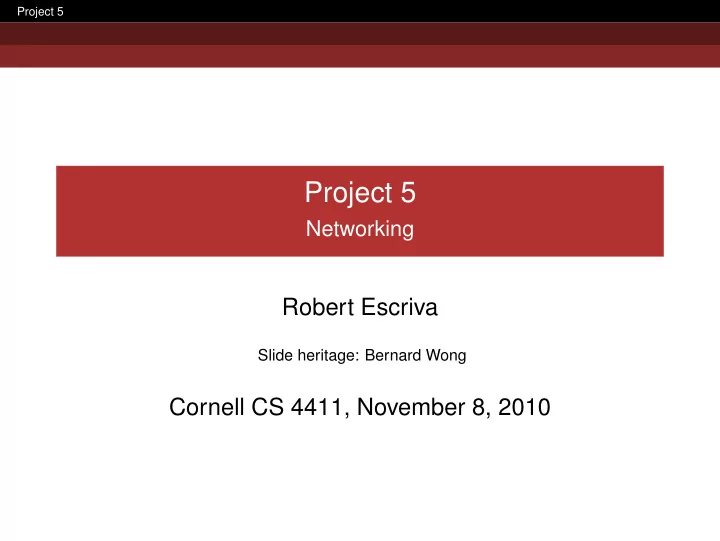

Project 5 Project 5 Networking Robert Escriva Slide heritage: Bernard Wong Cornell CS 4411, November 8, 2010
Project 5 Announcements Project 4 due Wednesday at 11:59PM. Project 5 will be due November 21 at 11:59PM. Web page is being updated frequently; check for updates.
Project 5 There are three kinds of death in this world. There’s heart death, there’s brain death, and there’s being off the network. Guy Almes
Project 5 The 1,000 Foot Picture 1 Project Scope 2 Implementation 3
Project 5 The 1,000 Foot Picture What is an “ad-hoc networking layer”?
Project 5 The 1,000 Foot Picture What is an “ad-hoc networking layer”? Ad-hoc networking enables wireless communication without the need for infrastructure What is it useful for? Removes infrastructure costs. Allows quick deployment. Potentially more reliable (no single point of failure). Based on Dynamic Source Routing. ∗ ∗ http://www.cs.cornell.edu/People/egs/615/johnson-dsr.pdf
Project 5 Project Scope What do you mean by routing? Packets that arrive at your machine may not be meant for you. Packets not meant for you should be routed to their destination. Add a routing layer between the network and transport layer. Both minimsg and minisocket implementations should work on top of miniroute.
Project 5 Project Scope The new header in pictures User Application Minisocket Header Minimsg Header Miniroute Header Network
Project 5 Project Scope How does DSR work? DSR is a reactive protocol. When a host does not know the route a packet, it must discover the route. It does so by sending a route discover packet . A route discover packet is broadcast to all hosts within proximity of a wireless signal. Hosts will re-broadcast discovery packets if they are not the destination. The host will add itself to the constructed route. The destination will send a route reply packet along the reverse route.
Project 5 Project Scope Routing protocol (common case) If a route contains A → B → C where A is the source, C is the destination, C will flip the route to C → B → A to send a reply to host A. Upon receiving a reply, it will add this route into its route cache, and use it to send data. Route cache entries expire in 3 seconds to prevent stale cache entries. Route discovery must be performed again upon route expiration. Is there a better way to do this?
Project 5 Project Scope Routing protocol (failure conditions) How does the protocol terminate? By tracking a time-to-live ( ttl ) value. What should the ttl be initialized to? What happens when ttl = 0? How do we prevent redundant re-broadcasts? We can re-use a trick you’ve seen before. How do we prevent loops?
Project 5 Implementation What do you need to implement? Convert calls to network_send_pkt to miniroute_send_pkt . Update the network handler. Interpret the miniroute header. Handle routing control packets. Deliver packet as usual if the destination has been reached.
Project 5 Implementation Routing Cache The cache must be able to hold SIZE_OF_ROUTE_CACHE entries. Old items are invalidated after timeout. Alarms may be used, but it can be done without. This should be somewhat efficient, as you may increase SIZE_OF_ROUTE_CACHE to be large. Aim for O ( 1 ) or O ( log n ) bound on operations. Think in terms of hash tables, scatter tables, and trees.
Project 5 Implementation Additional implementation requirements Need to track recently seen discovery packets. Eliminate redundant broadcasts. Write an Instant Messenger application that runs on miniroute. Read input from the user (look at read* ). Add miniterm_initialize to your system initialize functions. miniterm_read will let you read from the keyboard.
Project 5 Implementation Broadcast information Set BCAST_ENABLED to 1. Set BCAST_ADDRESS : 192.168.1.255 for ad-hoc network (see instructions for setting up an ad-hoc network). x.y.z.255 for CSUGLAB. When debugging: Set BCAST_TOPOLOGY_FILE . Provide a topology file (see project description). Test without wireless. Use only in CSUGLAB.
Project 5 Implementation Additional requirements Only put one routing discover request per destination on the network at any one time. Multiple threads should not trigger multiple routing discovery requests for the same destination. Use the latest route reply packet (use the seq_no for this). Use the structures and data-types provided in miniroute.h : Allows all groups to route an arbitrary group’s packets. It’s unlikely minimsg and minisockets will be groupwise-compatible.
Project 5 Implementation Additional requirements Routing interoperability requires headers be in network byte order. Use the same endianness conversion you used in project 4.
Project 5 Implementation Feeling ambitious? Remove the routing cache timeout: Instead, detect broken links and perform re-perform discovery. Requires verifying that hops work. Hop-to-hop acknowledgements are very † inefficient. Take advantage of broadcasting to see when the next host forwards the packet. Faster (less sends). Requires more work. † very
Project 5 Implementation Feeling more ambitious? Localized route patching. When hop-to-hop communication fails, have the hop that detects the failure perform a new route discovery. Patch the route on the failed packet to allow it to route successfully. Source and destination should be updated to reflect new route.
Project 5 Implementation Feeling even more ambitious? Cache aggressively There are lots of opportunities to cache more. Every packet presents the chance to update the cache. Just because you can does not mean you should. Some data is not worth caching.
Project 5 Implementation Feeling even more ambitious? Redundant routes Keep multiple routes to the same destination in cache. When the source receives an error, the backup route may be used. Consider how you could extend the header to encode multiple routes.
Project 5 Implementation If you eat and breath this stuff Hybrid proactive/reactive routing protocols See Professor Sirer’s SHARP ‡ ‡ http://www.cs.cornell.edu/courses/cs414/2004SP/papers/sharp.pdf
Project 5 Implementation Concluding thoughts Have some fun with this project. It’s much less work than P4, and much more fun too. Come see the TAs in office hours § . § some of the TAs get lonely
Recommend
More recommend